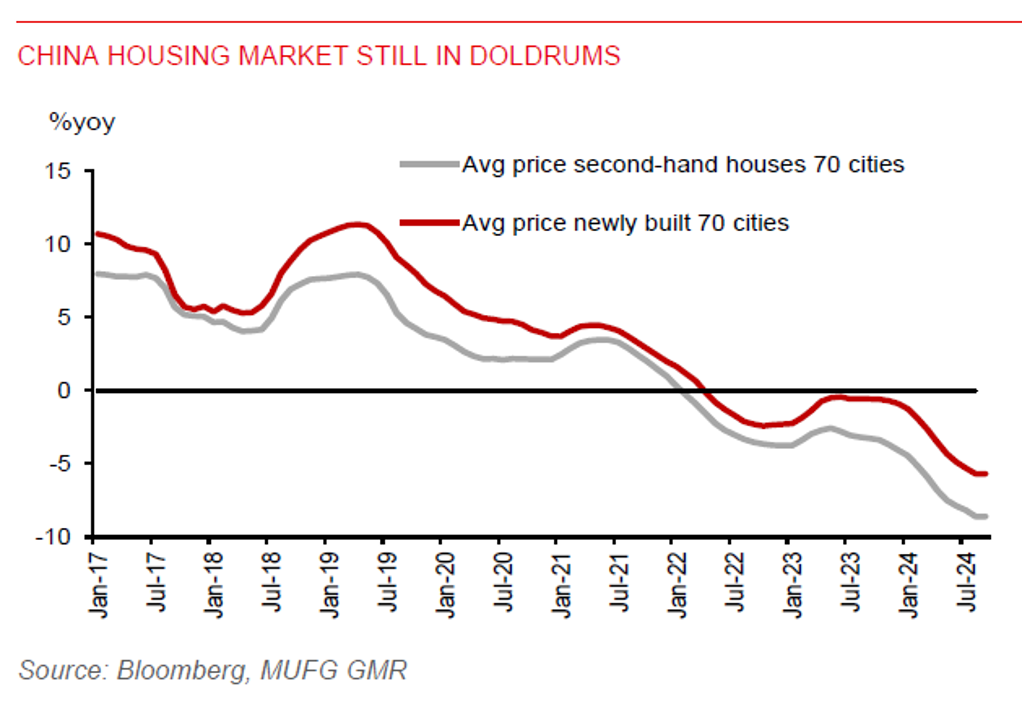Ahead Today
G3: ECB Villeroy speech
Asia: China trade, India CPI
Market Highlights
The US dollar index fell 0.1% to close at 102.89 last Friday. US dollar gained 0.4% against JPY to close at 149.13 but not enough to offset US dollar weakness elsewhere. The US economic calendar was relatively light. US PPI was flat in September, while core PPI rose 0.2%mom, slowing from 0.3% in August and in line with expectation. The University of Michigan consumer confidence index softened to 68.9 from 70.1.
The key highlight over the weekend was China’s finance ministry briefing. Markets had expected the government to deploy RMB2 trillion (US$283bn) of fresh fiscal stimulus. Officials said there’s large room to raise public debt and the fiscal deficit but stopped short of providing the specifics. Markets are left to wait for the upcoming meeting of China’s top legislature at the end of the month for more concrete measures. While Finance Minister Lan said local governments have RMB2.3tn funds from special bonds, that is not new stimulus. Those funds are from unused bond proceeds and bonds not issued yet but fall within this year’s quota. Meanwhile, officials said local government bond proceeds can be used to buy unsold homes. However, past housing rescue funds, including a RMB300bn program for commercial banks to lend, have not been effective. Special sovereign bonds will also be used to recapitalize large state-owned banks to ease any pressure resulting from a broad reduction to mortgage rates.

Regional FX
Asia ex-Japan currencies broadly strengthened against the US dollar last Friday, with THB (+0.7%) and IDR (+0.5%) leading gains across the Asia region. In line with our expectation, MAS left the slope, centre, and width of its currency band unchanged amid still sticky core prices and upside risks to oil prices from geopolitical tensions in the Middle East. We maintain our outlook that a policy pivot will likely be in early 2025, when core CPI steps down further towards MAS soft inflation target of 2%. Meanwhile, advance estimates show Singapore’s Q3 GDP growth picking up to 2.1%qoq, from 0.4% in Q2. From a year ago, Singapore’s GDP rose 4.1%, from 2.9% in Q2 and beating Bloomberg consensus of 3.8%.
Also, in line with our and market expectation, the Bank of Korea cut the policy rate by 25bps to 3.25% last Friday, as the domestic economy has slowed, local property market shows signs of cooling, and inflation has fallen back below the central bank’s 2% target. However, it was a hawkish cut, as five of seven members of the board see the policy rate staying at 3.25% for the next 3 months, while one member – Chang Yongsung - dissented. Policymakers remain mindful of the trade-off between supporting domestic growth and maintaining financial stability.
Meanwhile, China’s CPI inflation remained muted at just 0.4%yoy in September, down from 0.6%yoy in August, pointing to domestic demand challenges. There’s no new fiscal stimulus being announced at the finance ministry briefing to spur household consumption.
